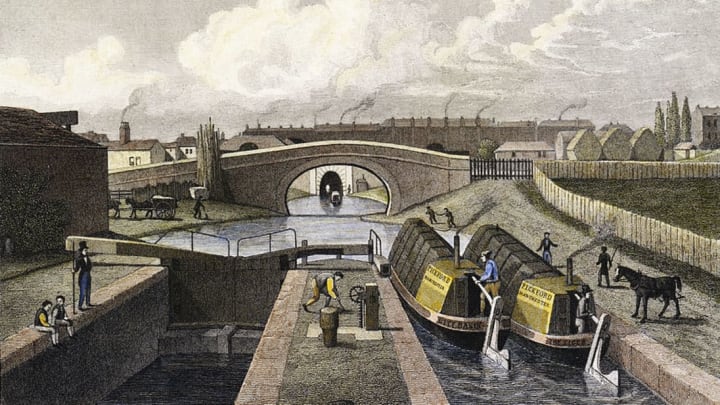In September 1818, in the British city of Nottingham, a boat hand named Joseph Musson went to work, unaware that he would not see the end of the day.
Musson worked on a boat that transported barrels of gunpowder to the coal mines in Derbyshire, where workers used it as a blasting agent. As workers carried a leaky barrel from the boat to the warehouse, some powder spilled out on the wharf. When Musson dropped a hot cinder on it, more than 20 barrels of gunpowder—totaling about 2000 pounds—exploded.
He was thrown backwards more than 100 yards; the building and several vessels were demolished. The Nottingham Date Book of 1818 reported “mangled bodies [and] destroyed buildings,” according to The Nottingham Post. Warehouses containing paper, whalebone, oil, and grain were blown apart, and windows on homes and buildings were shattered streets away. Some victims' remains were found in a meadow over 300 yards from the site.
“It was the loudest explosion that had ever been heard in England at the time,” Gerry Mulvaney, director of the Nottingham Narrowboat Project, which operates close to where the explosion occurred, tells Mental Floss. “It destroyed all the buildings around.”
Joseph Musson was one of 10 people killed in the Nottingham blast. But he wouldn’t be the last casualty of the dangerous industry that powered Victorian Britain.
The Dark Side of the UK’s Canal Age

The "canal age" in the UK began in the 18th century. Horse-drawn canal boats provided a way to move raw materials between factories and ports more quickly and inexpensively than transporting the same cargo by road. The canals linked manufacturing centers across the country to the sea, and gave merchants access to new markets for their products, fueling the Industrial Revolution. The volume of goods carried by canal boat increased, which had a positive effect on Britain’s economy: By one estimate, Great Britain's output of coal—one of the main materials transported by canal boat to manufacturing centers—increased sixfold from about 5.7 tons in 1750 to 33.5 tons in 1830.
But there was a dark side to this progress.
Early canal workers faced lethal dangers associated with their grueling work. "There were many accidents, especially in the winter,” Lorna York, whose family worked the canal system from 1796 to 1918, tells Mental Floss. “Drowning, being crushed in a lock, limbs being caught in moving ropes, and so on.” During this time, there was little medical assistance available for those who got into trouble.
Conditions for canal workers were cramped and uncomfortable, since the bulk of the space available on board the canal boats was used for the storage of raw materials like coal. “There would be a tiny cabin at the back, where you’d usually have a skipper and very often a young boy as an apprentice, and they would live in this cabin,” Mulvaney says. “Sometimes, there might be a family in there as well.”
Their cargoes posed a threat, too. Industrial accidents involving gunpowder were a fixture of the Victorian era: Two powder magazines on the south bank of the River Thames blew up in 1864, ammunition materials exploded at Woolwich Arsenal in 1866 and 1867, and a blast destroyed a Yorkshire fireworks factory in 1868.
And the Nottingham incident in 1818 wasn't the only explosion of its kind. Early one morning in 1874, a similar accident took place on the Regent’s Canal in London under Macclesfield Bridge—later known colloquially as Blow-Up Bridge. The Tilbury, a barge traveling as part of a small convoy on the way to Nottingham, carried cargo that included barrels of petroleum and five tons of gunpowder. The materials caught fire, resulting in a blast that killed the crew, smashed windows, and destroyed the bridge and a nearby house.
Major Vivian Dering Majendie, Queen Victoria’s Inspector of Gunpowder Works and now considered one of the first bomb disposal experts, investigated the accident. Despite the loss of life and damage to infrastructure, Majendie wrote that "the explosion occurred under exceptionally favorable circumstances” [PDF] due to the high banks of the canal deflecting the force, and because a large amount of the force was absorbed as the bridge was destroyed. “Measured by possible consequences, it must be admitted that we have bought our experience in this matter cheaply,” Majendie wrote.
Safer Days On The Canals

The Regent's Canal accident had consequences. The company that owned the Tilbury was condemned for the “highly imprudent and improper” act of shipping petroleum and gunpowder on a single boat, according to the Canal and River Trust's publication Waterfront. In 1875, the Explosives Act was passed—accelerated by the 1874 Regent’s Canal blast—which amended the law with respect to the manufacture, keeping, selling, carrying, and importing of gunpowder, nitroglycerine, and other explosive substances.
Today, the canals that saw so much death and destruction are a much safer part of British history. Canal and River Trust volunteers maintain the canals and keep old lock gates in good working order so that boaters may continue to use them. The canal towpaths are beautiful places to take a stroll, and renting a narrowboat for a few days or taking a guided boating trip remain popular choices for UK holidaymakers.
And the early canal workers, who braved the rudimentary and sometimes perilous working conditions, are remembered for ensuring that the country would prosper in the Victorian era.
